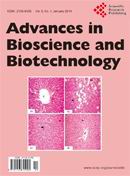Ver ítem
- xmlui.general.dspace_homeCentros e Institutos de InvestigaciónCICVyA. Centro de Investigación en Ciencias Veterinarias y AgronómicasInstituto de VirologíaArtículos científicosxmlui.ArtifactBrowser.ItemViewer.trail
- Inicio
- Centros e Institutos de Investigación
- CICVyA. Centro de Investigación en Ciencias Veterinarias y Agronómicas
- Instituto de Virología
- Artículos científicos
- Ver ítem
Comparison of transient and stable expression of foot-and-mouth disease virus capsid proteins in mammalian cells
Resumen
Foot-and-mouth disease is a highly contagious disease that produces severe economic losses in the livestock industry. This disease is being controlled by the use of an inactivated vaccine. However, the use of recombinant empty capsids as a subunit vaccine has been reported to be a promising candidate because it avoids the use of virus in the vaccine production. A plasmid containing the capsid precursor P12A and protease 3C sequences of foot-and-mouth
[ver mas...]
Foot-and-mouth disease is a highly contagious disease that produces severe economic losses in the livestock industry. This disease is being controlled by the use of an inactivated vaccine. However, the use of recombinant empty capsids as a subunit vaccine has been reported to be a promising candidate because it avoids the use of virus in the vaccine production. A plasmid containing the capsid precursor P12A and protease 3C sequences of foot-and-mouth disease virus (FMDV) was constructed and used to compare transient and stable expression in mammalian cells. When BHK-21 cells were transfected with the recombinant vector, protease 3C cleaved the capsid precursor P12A into the structural proteins VP0, VP1 and VP3. A sucrose gradient demonstrated that the structural proteins assembled into different subviral particles. Attempts to generate a stable cell line only allowed isolating low-level-expressing clones, probably due to the effect of protease 3C on the cells. Moreover, the recombinant protein yield achieved in transient expression assays was much higher than the one achieved in stable expression assays. Results indicate that mammalian cells are a good strategy to produce recombinant FMDV subviral particles. However, the alternative approach of transient gene expression in scalable systems should be used instead of the standard method that involves the generation of a stable cell line.
[Cerrar]

Fuente
Advances in Bioscience and Biotechnology 4 (12) : 1024-1029 (December 2013)
Fecha
2013-12
Editorial
Scientific Research
ISSN
2156-8456
2156-8502
2156-8502
Formato
pdf
Tipo de documento
artículo
Palabras Claves
Derechos de acceso
Abierto
 Excepto donde se diga explicitamente, este item se publica bajo la siguiente descripción: Creative Commons Attribution-NonCommercial-ShareAlike 2.5 Unported (CC BY-NC-SA 2.5)
Excepto donde se diga explicitamente, este item se publica bajo la siguiente descripción: Creative Commons Attribution-NonCommercial-ShareAlike 2.5 Unported (CC BY-NC-SA 2.5)


